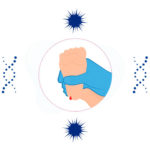Targeting treatments for vascular anomalies, courtesy of cancer genetics

Vascular anomalies — overgrowths or malformations of the capillaries, veins, arteries, and/or lymphatic vessels — often confound physicians, especially in acute settings. They encompass a diverse group of conditions, all of them rare, and can affect multiple body systems. Many physicians have never encountered vascular anomalies and may be unaware of the risks they sometimes pose, such as constriction of the airway or spinal cord or excessive bleeding.
“If you have a vascular anomaly and show up in the emergency department, you may not get referred to the right specialist due to confusion about what these disorders are and what treatments exist,” says Whitney Eng, MD, MPH. “People can get lost in the system.”
Eng saw her first patients with vascular anomalies in the Dana-Farber/Boston Children’s Cancer and Blood Disorders Center, where she managed their bleeding and clotting complications. She is now part of the Boston Children’s Vascular Anomalies Center team as well, and the two programs often partner on vascular anomalies cases.
Eng sees patients from all over the world. Many have received incorrect diagnoses at various hospitals and have had multiple operations and interventional radiology procedures — some causing more harm than good. “Sometimes families are literally in tears to know that there’s a treatment for their child’s condition and that they’re not alone.”
Eng is now hoping to bring precision medicine to vascular anomalies and change the paradigm of care. “We’re just starting to learn about genetic changes in vascular anomalies,” she says. “This gives us an opportunity to treat patients with targeted medicines rather than a surgical approach.”
Taking cues from cancer biology
Eng’s dual background in oncology and vascular anomalies has proven to be an advantage. While not cancers, vascular anomalies share some molecular features of cancer and involve abnormal growth.
“Patients have tumors and abnormal tissue that do not progress to a true malignant cancer,” Eng explains. “However, if you sequence tumors, a lot of the mutations are in similar genes. Some pathways involved in cancer, such as the PI3K–mTORand RASpathways, are also involved in vascular anomalies.”
Many vascular anomalies have now been redefined and renamed based on their underlying genetic mutation. These mutations are frequently somatic, occurring after conception and only affecting certain tissues — often fewer than 10 percent of cells. And some can be targeted with existing cancer drugs.
To build on this idea, Eng has leveraged OncoPanel, a clinical-grade test that sequences more than 400 known cancer genes. She and her colleagues tested affected tissue from 137 patients with vascular anomalies, from newborns to age 19. Overall, 80 patients had clinically actionable genetic variants, including 58 who had changes relevant to their treatment. To date, 18 patients have received targeted therapies also used in cancer.
“OncoPanel wasn’t designed for patients with somatic variants occurring at a low frequency, so it’s incredible that we’ve been able to get results,” says Eng.
Treatment successes
Treatment with targeted oncology drugs has been life-changing for some. One patient with a venous malformation affecting his mouth, airways, rectum, and other parts of his body, had had more than 80 blood transfusions due to uncontrolled bleeding. Finding a mutation in PIK3CA, a gene also implicated in breast cancer, Eng started him on alpelisib, a breast cancer drug that targets PIK3CA. He hasn’t needed a transfusion since.
Meet Isaac

Isaac had a complex malformation of his face and lesions in his tongue, lip, and jaw, and episodes of bleeding from his mouth. Diagnosed by OncoPanel as having PROS, he is now receiving an AKT inhibitor. His malformation has shrunk, and he feels less fatigued with fewer bleeding episodes. Read more.
Another patient with Klippel-Trenaunay syndrome, now classified as part of PIK3CA-Related Overgrowth Syndrome (PROS), was wheelchair-bound with numerous lymphatic blebs (fluid-filled protrusions). She was prescribed an AKT inhibitor, which acts on the PI3K-mTOR-AKT pathway and is in clinical trials for several cancers. With treatment, she is more active, with a markedly better quality of life. The Vascular Anomalies Center team is also using AKT inhibitors for some patients with CLOVES syndrome, now also classified under PROS.
A patient with Kaposiform lymphangiomatosis (KLA), an aggressive lymphatic anomaly, had a mutation in the RAS pathway. Treated with trametinib, an inhibitor of MEK (part of the RAS pathway) that is used in melanoma, they went from being wheelchair-bound with trouble breathing to running a 5K race. Boston Children’s is also testing trametinib in patients with mutations in MEK and complicated arteriovenous malformations.
Scaling up precision medicine for vascular anomalies
Currently, Eng is the Boston Children’s site principal investigator on several clinical trials for patients with vascular anomalies. These include a trial for PROS and a trial for both PROS and Proteus Syndrome. When drugs are unavailable through traditional means, she files single-patient Investigational New Drug requests with the FDA to treat her patients under compassionate use protocols. She and her team are moving toward larger clinical trials of PIK3CA inhibitors, AKT inhibitors, and MEK inhibitors, using a first-of-its-kind gene panel they have created specifically for vascular anomalies. Eng also plans to further investigate patient samples in which no genetic mutation has yet been found.
Boston Children’s isn’t doing this work alone. The hospital has joined with more than 20 other pediatric hematology/oncology sites to form the Consortium of Investigators of Vascular Anomalies (CaNVAS). The consortium is establishing patient registries and clinical trial collaborations.
Here in Boston, the Vascular Anomalies Center holds a weekly Zoom meeting to review complex cases from around the world. Specialists from multiple fields participate, as well as families looking for second opinions. “We want to share our knowledge with pediatricians and other specialists,” says Eng, “so people can get the treatments they need.”
Learn how the Vascular Anomalies Center at Boston Children’s Hospital and the Dana-Farber/Boston Children’s Cancer and Blood Disorders Center collaborate to care for children with capillary, venous, arterial, and lymphatic malformations.
Related Posts :
-

Newborn genetic screening for pediatric cancer risk could save lives
Numerous genetic mutations increase children’s risk for various cancers. When they are detected early, cancers can potentially be caught ...
-

Using genetics to glimpse newborns' future with congenital heart disease
Aside from infections, congenital heart disease (CHD) is the leading cause of infant mortality. Informed by babies she sees in ...
-

Sudden, unexplained child deaths often have a genetic cause
When a baby or toddler dies without warning, parents often blame themselves. A study at Boston Children’s may provide ...
-

Another use for mTOR inhibitors: Preserving vanishing bones in Gorham-Stout syndrome
The mTOR pathway is fundamental to nearly every cell in the body. It drives processes related to cell growth, protein ...





